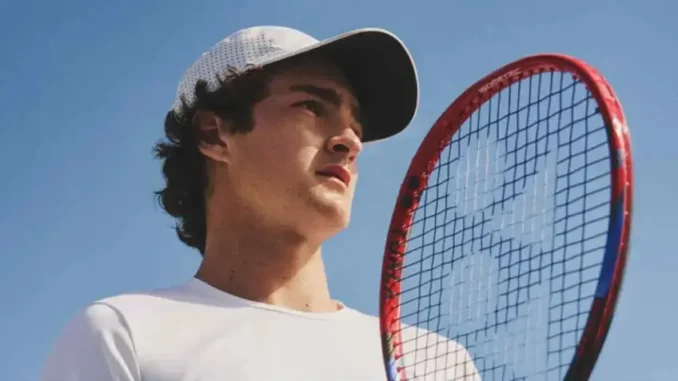
At just 18 years old, João Fonseca has set the tennis world ablaze, sparking fervent debates about whether he’s the sport’s next superstar or a young talent overhyped by early success. The Brazilian phenom, ranked world No. 57 as of June 2025, has achieved milestones that place him among tennis’s elite prospects. From winning the 2024 NextGen ATP Finals to securing his first ATP 250 title in Buenos Aires, Fonseca’s rise has been meteoric. Yet, critics question whether the hype surrounding the Rio native—fueled by passionate crowds and comparisons to Carlos Alcaraz and Jannik Sinner—is premature. As Fonseca prepares for his next challenge at the Halle Open, the tennis world is watching to see if “Fon-SAY-Cah” can live up to the lofty expectations.
Fonseca’s journey began in Ipanema, Rio de Janeiro, where he started playing tennis at age four on the clay courts of the Rio de Janeiro Country Club. Born into a well-off family—his father, Christiano, is a hedge fund CEO, and his mother, Roberta, a former athlete—Fonseca had access to top-tier facilities, a rarity in Brazil’s soccer-dominated sports culture. His talent shone early, culminating in a historic 2023 when he claimed the US Open boys’ singles title and became the first Brazilian to end the year as the No. 1 junior. “I was born with this gift of being calm,” Fonseca said, reflecting on his composure after stunning world No. 9 Andrey Rublev in straight sets at the 2025 Australian Open, a victory that marked him as the first teenager since 2002 to defeat a top-10 player in a Grand Slam first round.
His professional breakthrough came in 2024 at the Rio Open, where, as a wildcard ranked No. 655, he delivered a 6-0, 6-4 thrashing to seventh seed Arthur Fils, becoming the first player born in 2006 to win an ATP match. Fonseca reached the quarterfinals, a feat that saw him rocket 300 spots in the rankings. He followed this with a second ATP quarterfinal in Bucharest, defeating Lorenzo Sonego, and a first-round win at the Madrid Open, his Masters 1000 debut. His crowning moment came in February 2025, when he won the Argentina Open, making him the youngest South American to claim an ATP title since 1990. “This was just an unbelievable week for me. Of course I want to be No. 1. Of course I want to win Slams,” Fonseca declared, his ambition clear.
Critics, however, point to inconsistencies in his game. Despite his ferocious forehand—clocked at an average speed of 81 mph with a spin rate of 3,019 rotations per minute, per ATP stats—Fonseca’s aggressive style can falter against seasoned opponents. His second-round loss to Sonego at the Australian Open and a defeat to Alex de Minaur at the Miami Open, despite leading early, highlight moments where inexperience cost him. “When I was young, I always loved to hit winners, but sometimes the ball was going to the fence,” Fonseca admitted, acknowledging his need for patience. Ugo Humbert, after losing to Fonseca in Miami, compared his pace to Alcaraz and Sinner, saying, “I’ve rarely played against a guy who played so fast.” Yet, Fonseca’s 4-9 record in ATP Tour-level matches since Buenos Aires suggests he’s still learning to navigate the pro circuit’s demands.
Supporters argue that Fonseca’s potential is undeniable. His victory over Hubert Hurkacz at the 2025 French Open showcased his ability to dominate top-30 players, earning praise from Stefanos Tsitsipas, who predicted, “We’re going to see big things from him in the next few years.” Fonseca’s mental strength, likened to a “Kevlar-thick” resolve, and his ability to draw soccer-like crowds in Melbourne, Miami, and Rio add to his allure. “I knew it was going to be crowded, but I didn’t know it was going to be, like, huge,” he said of the Miami Open, where Brazilian fans turned matches into a carnival. His NextGen Finals triumph, where he went undefeated, further cements his credentials, joining Alcaraz and Sinner as an 18-year-old champion.
The debate over Fonseca’s hype hinges on perspective. At 18, his achievements—top-100 debut, a Grand Slam top-10 upset, and multiple titles—are extraordinary. Yet, losses to players like Jack Draper at Roland Garros and Cameron Norrie in Madrid reveal gaps in consistency and tactical nuance. “In important moments, I just try to be brave,” Fonseca said, emphasizing the mindset that sets top-10 players apart. With endorsements from Roger Federer’s brand On and mentorship from Gustavo Kuerten, Fonseca’s resources and support system are robust. Whether he’s overrated or a future No. 1, his fearless style and raw talent ensure he remains a player to watch.
Leave a Reply